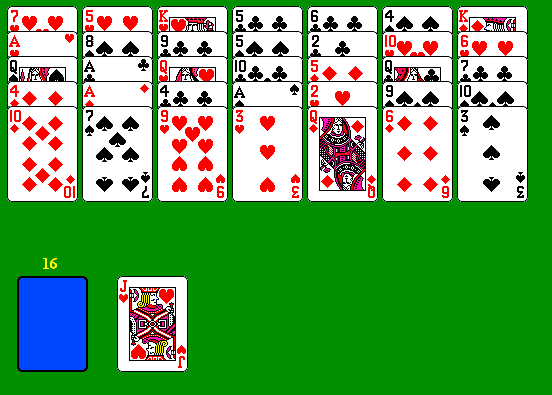
Golf Solitaire and its variants
The Game of Golf Solitaire
One of the oldest forms of solitaire is a game originally
called One Foundation (in, for example, Tarbart's
1905 Games of Patience).
Seven columns of cards are dealt, one row at a time, until each column
has
five cards. The rest of the deck forms a stock, and
the first card is
turned over to form what looks like a waste pile. But it is
not a normal
waste; cards are never played from the waste, but uncovered cards from
the tableau columns
can be built onto the card currently on top of the waste, ascending or
descending in rank,
regardless of suit. In the sample deal below (49621 in the
Solitaire
Laboratory program), either the ten of diamonds or the queen of
diamonds can be played on
the jack of hearts; if the ten is played it may be followed by the nine
of
hearts. Changes of direction are allowed at any time;
e.g. 6-7-6-5-6-5-4
is a legal sequence if each card is available in turn (one source
mistakenly and
hilariously says that you must play in one direction; the game
definitely does not
work that way).
When no more plays are possible (or
desired), the next card from the stock is turned up. The
objective is to play all
35 cards from the tableau columns onto the waste; there is
no
redeal.
In the original form of
the game, only twos could be played on aces, and only kings on queens,
so e.g. 3-2-A-2-A-2 or J-Q-K-Q-K was a legal sequence.
Someone (possibly Bonaventure in his 1931 Games of Solitaire)
introduced a malevolent rule that nothing, even queens, could be played
on kings, so after a king was dealt or played to the waste, the next
stock card had to be turned up. I'm not sure of the
original source of the rule that kings stop
the sequence, but it appears mostly in American
books. But I think the best form of the game allows ranks
to wrap around, so that
kings and aces can be played on each other; this rule has been adapted
in almost every
major variant. Donald Sapsford's 1970 Card Tricks and Patience includes a
version called Six-Six Patience,
with six columns of six cards, with wraparound discards. Since
most deals end up with cards left over in the tableau columns, someone
(possibly Bonaventure again) had the
idea of keeping score by how many cards are left in the columns on each
deal, and the game
got its present-day name Golf . Morehead
and
Mott-Smith suggest that the win rate for the traditional game (nothing
played on kings) is about
5%, and a reasonable par score per hole is 4. Of course,
there is no such
thing in real golf as a score of zero: a hole-in-one scores 1, but this
does not spoil
things: in fact, you can even allow negative scores by giving -1 for
each card left in the stock if the tableau is cleared (suggested by,
among others, Basil Dalton's 1948 The Complete Patience
Book). More
elaborate scoring systems have been introduced in variants (see
TriPeaks below). Golf is generally a better game when all of the
cards in the columns are
dealt face up, since the opportunity for skillful forward
planning is increased,
but variants with face down cards are often seen. Golf can
be played as a competitive solitaire, although it is tedious to
duplicate the same layout for both players unless it is played by
computer.

The start of deal number 49621 in standard Golf. The player can either play the queen, or the 10 and 9.
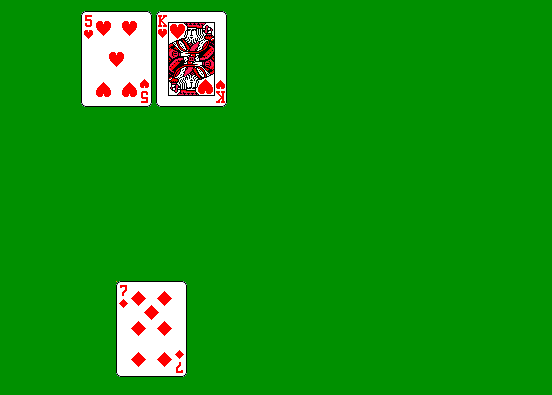
The end of the same deal, showing the last card dealt from the stock and two cards left in the columns.
Pyramid Golf and TriPeaks
A combination of two well-known solitaires, which I have never seen in books, but which appears quite often in computer versions, is Pyramid Golf, played by the same rules but with the normal pyramid of 28 cards (seven overlapping rows, starting with one card at the apex and adding one extra card in each row) replacing the seven columns of five (the stock is thus increased from 17 to 24). As in ordinary Pyramid, cards become available when both cards above them are discarded; the object is to discard all 28 cards from the pyramid. This is virtually always played with wraparound ranks; it would be nearly impossible to win otherwise. Even so, it is much harder than the standard game (the win rate is only a few percent). It does not play particularly well; the densely overlapped cards rarely give many choices of play and the skill level is much lower than standard Golf. Robert Hogue had the idea of overlapping three smaller pyramids, creating the very popular variant TriPeaks, which was included in the third of Microsoft's Windows Entertainment Packs in around 1991, and has become very popular in computer form. This layout opens up cards more quickly and puts the odds of winning in the player's favor. There is also an interesting scoring system which rewards long runs of consecutive cards played to a single waste card: one card is worth 1, two 3, three 6, four 10, etc. The Microsoft version was dealt with all covered cards face down until they are exposed. Hogue's own version allows for both forms; his 2001 version suggests face down as the standard, but starting with Windows Vista, Microsoft's version is face up. TriPeaks is also often seen on tabletop arcades found in restaurants and bars. Pretty Good Solitaire includes it under the generic title Triple Peaks. Below is a sample deal with all cards in the pyramids dealt face up.
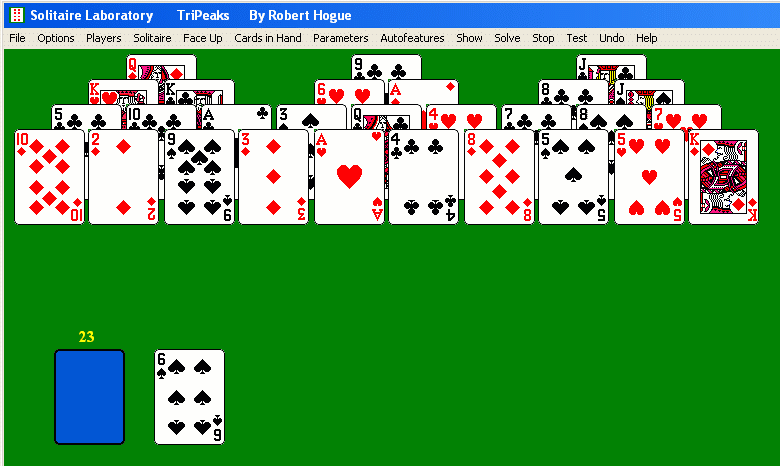
A deal of Robert Hogue's TriPeaks, in the face-up variant. It is possible to play 5, 4, 3, 2, A, K, Q on the initial 6.
A quick and straightforward version of TriPeaks with 25 variant layouts is Sheriff TriPeaks, available for play online at many sites. The whole game of 25 levels can be played in less than an hour; it's a clean one-deck design with no jokers or powerups. The closed layouts range from standard TriPeaks (level 2) to Pyramid Golf (level 25). Another online version, with a single standard closed setup and one joker per round, is Tri Towers Solitaire from Glowing Eye Games. Using a closed layout removes much of the skill factor introduced by adding a wildcard in each round.
Open variations
Pharaoh's Treasure -- BigPrizes.com
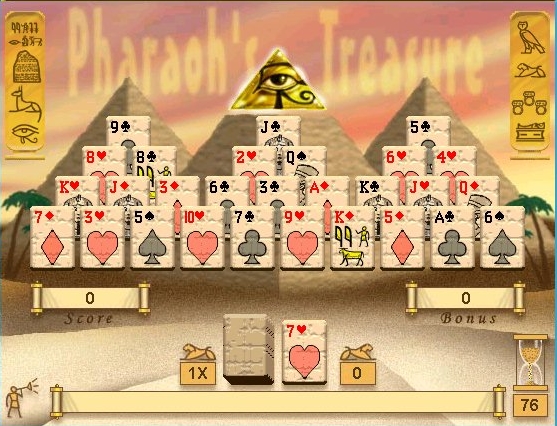
Perhaps the most interesting version of TriPeaks was an online
version on the
now-vanished website BigPrizes. This was designed by the
veteran solitaire
designer Warren Schwader, who now runs SoliTaire!
Network. Pharaoah's Treasure was a thematic game of
searching for ancient
treasure; the player starts out playing closed TriPeaks, and as the
game progresses, more
and more of the layout becomes open. There are also other
powerups.
Jokers and Powerups
Computer versions have introduced variants to increase the
skill level and the win rate
(giving players more choices usually does both). Paul DeWolf's
mid-1990's program Thieves and Kings (once again available) first
appeared as a two-game package, with a version of Golf
(mislabelled Forty Thieves)
with, typically, two jokers per deal. Jokers are also seen
in recent versions
such as Aloha TriPeaks, along with other powerups
such as the ability to
reshuffle the layout and redeal some portion of the stock. Another
powerup, seen in Fairway Solitaire (see the end of
this article), is to allow the player to peek at the top of the stock
which has not been turned up yet.
Another useful powerup is one I
call headstart, originally found in the easier version of
Sierra's Hoyle
Solitaire:
instead of turning up the first stock card immediately, any card or
legal
sequence of cards can be played to the empty waste before turning the
first stock
card. This usually lets the player get rid of at least two
or three cards
right away. I have extended this powerup in Solitaire Virtuoso by
showing the rank of the first stock card, so that the player avoids
wasting the headstart by playing cards which would be playable by the
first stock card.
Solitaire Virtuoso also has a Card Tracker, which shows all of the cards remaining in Golf and TriPeaks variants. This can help with strategic planning, and in the money version of TriPeaks, indicate whether there are useful cards left in the stock, so that a hopeless deal can be abandoned without wasting money turning extra stock cards.
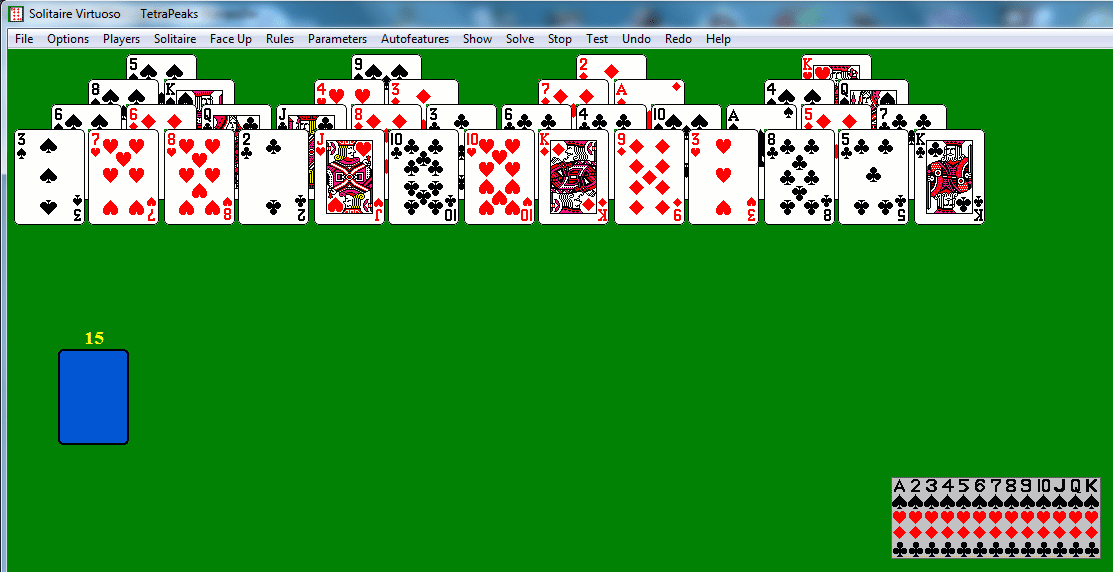
TetraPeaks
With Robert Hogue's permission, I have added a four-pyramid
open variant to Solitaire Virtuoso. This has a stock of only 15
cards, and is difficult to win even with headstart and Card Tracker,
though it does sometimes produce very impressive runs of cards.
Barbershop Quintet -- start of a new deal
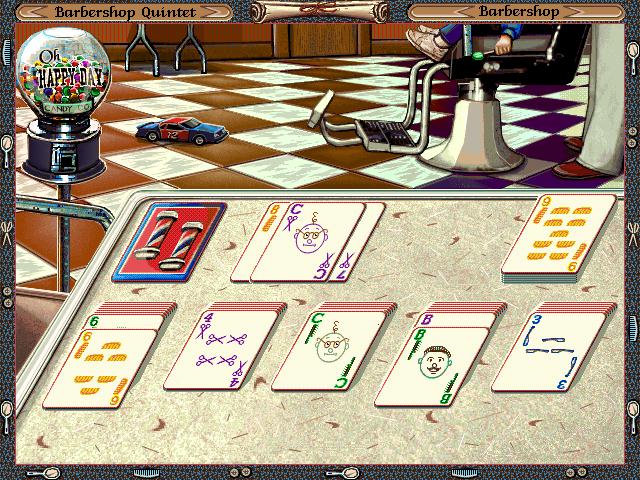
A deal in progress -- note the overlapping sets of cards in the waste
As part of his 1995 adventure game
Hodj 'n' Podj, Steve Meretzky
devised a new version of Golf themed to a barbershop, using a special
62-card deck containing five suits of 12 cards each, plus two wild
cards. Each suit contains a Customer (on which only 1's can be played),
a Barber (on which only 10's can be played), and cards numbered
1-10. There are also two Manicurists on which any card can be
played. The foundation starts empty; any card can be
played to start it. Thereafter, cards must be played up and down
in consecutive ranks as in ordinary Golf. The 12 special cards can be played to the foundation at any
time. The closed tableau has five columns of seven cards
each; the stock of 27 cards is dealt three at a time as in Demon
(Canfield). The tableau can also be packed in rank (e.g. an
8 from the top of one pile can be placed on an 8 on another pile) as in
Curds and Whey; this rule makes it easier to expose new tableau
cards and set up long sequences of foundation plays. The game is
unusual and reasonably skillful.
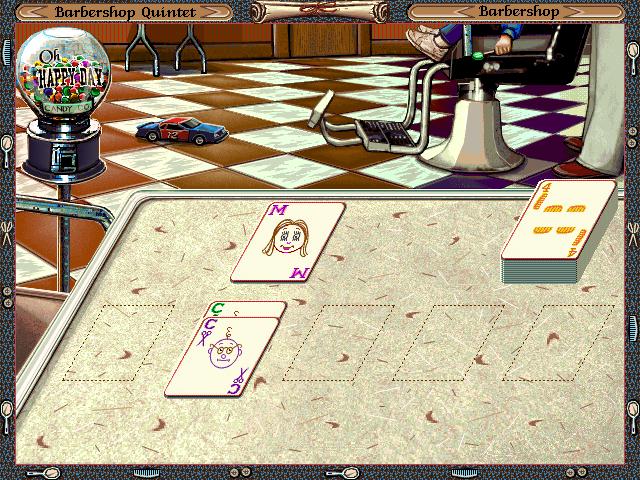
About to win at Barbershop Quintet -- all of the numbered cards have been played from stock and tableau; three of the specials were not even needed.
Multiple foundations
A number of variants have been devised with no stock and multiple foundation piles, including David Parlett's Striptease. In Striptease the four queens (for thematic reasons) are dealt in a row, and the rest of the deck (shuffled) is dealt on top of them, forming four columns of thirteen cards (the first four cards are dealt face down, the rest face up). These may be played, headstart style, into four foundation piles at will (wrapping around, and with jack and king considered as consecutive ranks). It is a quite challenging game with only four foundations; Sierra's Hoyle Solitaire has a simplified version with eight foundations, under the name Eliminator; this can also be found in the online SoliTaire! Network. Another variant is Ant's Solitaire, from Masque Software's Solitaire Antics series. This uses four random foundations and deals cards four at a time as in Aces Up. A very good version can be found in BVS Solitaire.
Black Hole
David Parlett took Golf to its logical conclusion, removing the stock entirely, and making the completely open variant Black Hole, probably the best and most skillful variant of Golf. It starts with the ace of spades as a single foundation card, and seventeen fans of three cards each. It is played in wraparound form, and several solvers have reported that almost 87% of deals can be won. Black Hole can be found in many large packages.
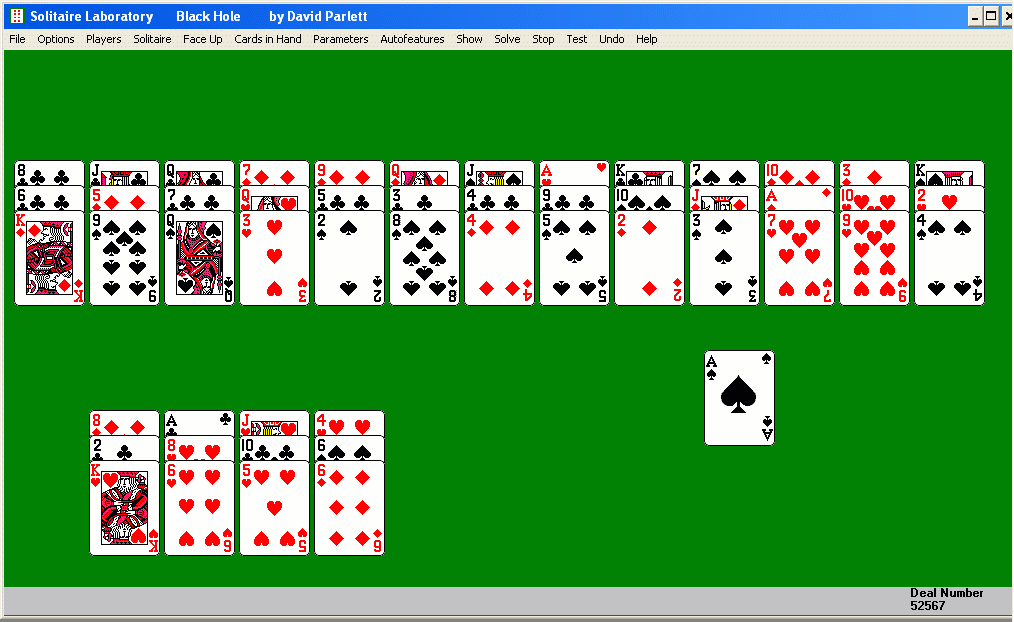
David Parlett's game Black Hole. Most deals require several changes of direction; this deal can be won by starting with a two and playing the ranks in strict increasing sequence.

A game first published in Henry Preble's 1909 book A Month of Solitaires,
and probably invented by him, has been misunderstood by most modern
sources as a predecessor of Black Hole, but in fact it has a different
discarding mechanism. The full deck is dealt face up into 13
columns of four cards each (Preble describes them as packets, but
unless the game is intended as a memory test, it makes more sense to
spread them as open columns). There is no discard pile;
available cards are removed in groups of two or more at a time in rank
sequence (in theory it might be possible to remove 13 cards at once on
occasion). At the start of the deal above, it is possible
to remove 8/9/T/J/Q/K (using either jack), or any portion of that
sequence consisting of two or more cards (removing the JH does not
permit the removal ofthe AC as part of the same sequence, since it was
not available at the start of that play). Alternatively the
sequence 2/3/4/5 or a part of it could be removed at
the start. After each group of two or more cards is removed,
another sequence is removed, which need not be consecutive with the
previous sequence: it can overlap or even be disjoint from the previous
sequence. If you remove 8/9/T/JC/Q/KD, your next play can be any
portion of K/A/2/3/4/5/6/7; it need not connect to either the 8 or K of
the previous play. The object is to discard all 52 cards (I was
able to win the deal shown with ten discarded groups). The
win rate is very high, about 99.98% according to Mark Masten's solver,
if played fully open. The game also appears in George A.
Bonaventure's 1931 Games of Solitaire
with the same rules; both authors suggest that you can make the game
more challenging by disallowing wraparound sequences (this drops the
win rate slightly, to 99.77%). Mark suggests restricting discards
to at least three cards, or even four. The game could also be
played closed, but with the columns spread so that you can see how many
cards each column has left after each discard.
Quasar
At some point,
someone badly misread the rules and assumed that All In A Row was played the same
way as Black Hole, with a single continuous sequence of single discards
starting from a tableau of 13 columns of four cards each, and allowing the
first discard to be any available card. It's hard to
see how this error could have arisen: the statement that All In A Row could
be played without wraparounds should have been a giveaway: the game
would then be impossible to win with an odd number of ranks. Regrettably, this mistake propagated quickly. Allowing a free first
discard does not compensate for the deeper columns; the mistaken game
has a win rate just above two out of three. Mark Masten suggests that this 13-column version of Black Hole be renamed Quasar (David Parlett agrees).
Fairway Solitaire
There are many thematic versions of Golf (and particularly TriPeaks); by far the best is Big Fish Games' smash success, Fairway Solitaire, which is reviewed on our Solitaire Arcade page. Gunslinger Solitaire, from Big Fish Games, is a weak imitation of Fairway Solitaire with a Western theme: numbered bullets (which can be purchased, along with other powerups) replace irons, and there are several shooting minigames.
This page was revised on August 16, 2021. All contents copyright ©2008-2021 by Michael Keller. All rights reserved.